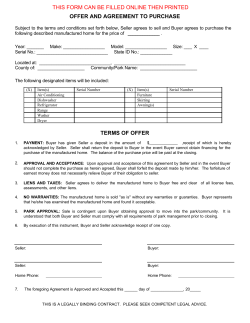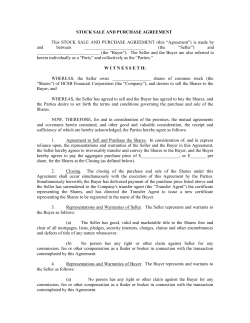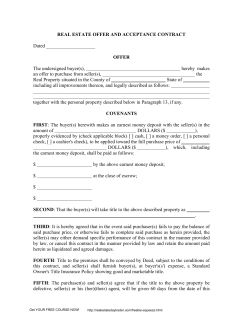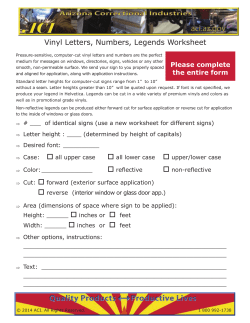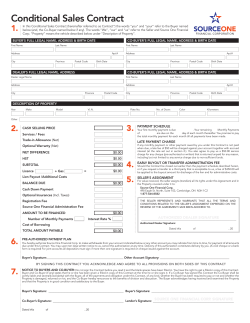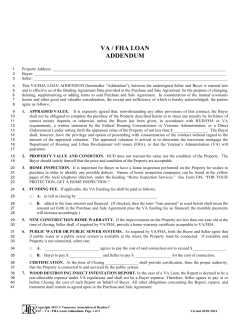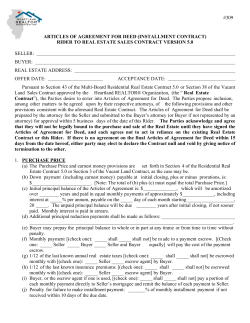
Forward Freight Agreements
Forward Freight Agreements Simpson Spence & Young Ltd • Established 1880 • Largest privately owned shipbroker in the world • Worldwide network of 15 offices • Represented on all major shipping committees & indices. 22 FFA Brokers in • Expertise in:London & Hong Kong – Dry Cargo – Tankers – FFAs – Research and Consultancy – Sale and Purchase – Agency and Towage Team of 10 analysts on tanker & dry bulk markets Forward Freight Agreements • The Role of The Baltic • The Baltic Panellists • The FFABA Forward Curves • Wet Vs Dry - Time Charter or Route • OTC Vs Cleared - Counterparty Risk • Market Growth and Volumes • Screen Trading Developments • FFA Recap and Summary Introduction to Dry FFAs. Four Baltic Type Vessel Sizes: •Capesize: Basis a Capesize 172,000mt dwt, not over 10 years of age,190,000cbm grain max. Loa 289m,max.beam 45m, draft 17.75m, 14.5knots laden, 15.0 knots ballast on 56mts fuel oil no diesel at sea. •Panamax: Basis a Panamax 74,000mt dwt, not over 12 years of age, 89,000cbm grain max. Loa 225m, max. draft 13.95m, 14.0knots 32/28 fuel oil laden/ballast and no diesel at sea. •Supramax: Standard “Tess 52” type vessel with grabs as follows: 52,454 mt dwt self trimming singledeck on 12.02m ssw189.99m loa 32.26 m beam 5ho/ha 67,756 cbm grain 65,600 cum bale 14L/14.5B on 30mt (380cst) no mdo at sea Cr 4 x 30 mt with 12 cum grabs Max age 10yrs. •Handysize: Basis a 28,000mt dwt, self trimming single deck bulkcarrier on 9.78mssw 169m LOA 27m beam. 5 ho/ha. 37,523 cum grain 35,762 cum bale 14 knots average laden/ballast on 22 mt ifo (380) no diesel at sea. 4 x 30mt cranes. Maximum age 15 years. BALTIC PANAMAX PANELLISTS The Baltic carries out annual “audits” on independent ship brokers. Companies who are doing sufficient business fixing individual routes and who demonstrate competence are invited to become panellists. The panellists make daily professional assessments of where routes should be priced. The Baltic oversee the assessments, publish results and calculate averages. Baltic Panamax Time Charter Average Component Parts 74,000mt - Transatlantic RV - 25% 74,000mt - Skaw-Gib/Far East - 25% 74,000mt - Japan-SK/Pacific/RV - 25% 74,000mt - Nopac-Aust/Sk-Pass - 25% The Panamax Time Charter Average is an unweighted average of four standard voyages. Panamax TC Avg 96.75% Correlation to Atlantic What is a swap? A Swap is a financial instrument that enables two parties to take an opposite view on the pricing of an asset. If crude oil is $50 per barrel one party might buy the swap the other could sell it. Its just like a bet on the direction the price will go in. They will agree a settlement date - the time to settle up and pay up. On the settlement date if Crude oil is $60 a barrel the buyer has made $10 a barrel profit. He has made the profit from a “paper” transaction, with none of the complication of buying, owning and then selling real crude oil. Traders buy and sell swaps in financial instruments like interest rates and currencies and commodities. What Is An FFA? An FFA or Forward Freight Agreement is simply a swap on freight costs. In just the same way that people buy commodities swaps to benefit from rising prices they can buy FFAs. They can also Sell FFAs if they believe freight prices will fall. Swaps always have a buyer and a seller - one will make money at the settlement and the other will lose it. It’s simple and easy to trade an FFA or Swap instead of really participating in the freight market. No need to own a ship, employ operations staff, fill it with crew, fuel, food, water etc etc. So why are people so keen to buy and sell FFAs? The Panamax Forward Curve - Basis 4th February 2011 Basis Spot Price $10,786 + $297 •Forward pricing is derived from the cash or spot market. •FFA Brokers discover the price of the different periods by calling the market participants. •The “Bid” is the price of the highest buyer. •The “Offer” is the price of the lowest seller. Elements of a Timecharter Average FFA • Buyer /Seller - Freight exposure / market view • Vessel Type - Cape, Panamax, Suezmax, Handy • Period - month / quarter / year • Quantity - number of days • Contract Price - Level traded • Contract Form - FFABA / ISDA • Clearing - LCH / NOS / SGX FFA SWAPS BUYER: Charterer Example 1 Market Rises July Settlement = USD 15,000 SELLER: Shipowner TYPE: BSI TC AVG Q3 09 Sett. value = 15,000 - 14,000 X 31 Days = USD 31,000 BUYER PROFITS RATE: USD 14,000 Example 2 - Market Falls QUANTITY: 92 days PERIOD: July, Aug, Sep 09 Aug Settlement = USD 13,000 Sett. value = 13,000 - 14,000 X 31 Days = USD (31,000) SETTLEMENT: Avg of all index Days SELLER PROFITS SETTLEMENT DATES: Last Day of each Month. Trading Example •In early July a Chinese Steel Mill is keen to lock in low freight costs in Q4 of 2009. •The Spot price is $23,199 a day . •Q4 is $17,250/$17,750 •An FFA is bought at $17,500. •If the spot price goes up in Q4 the FFA will fix the freight cost at around $17,500. •If the market falls the cost will still be locked at $17,500. •A speculative gain from the market falling is sacrificed, but the FFA rate traded is more favourable than the physical price available. Trading Example Continued... It is July 8th 2009. A Chinese steel mill needs a Panamax in Q4. Trading Example Continued... The FFA Price Available is $17500 Trading Example Continued….. The Market in Q4 is higher but the Mill has locked in a lower rate with its FFA. How Can we Close our FFA? •An FFA can run until it settles or it can be closed early…. Example: March 4th ‘09 A ship owner sells Cal 10 at $14,250 opening an FFA. The market falls quickly by the 18th March Cal 10 is trading at $12,000. The owner Buys Cal 10 at $12,250 closing the FFA and adding $2,000 a day to his earnings for in just two weeks. 4th March Sell: $14,250 Opens FFA Position 18th March Buy: $12,250 Closes FFA Position Profit: $2,000 per day banked. Traditionally FFAs were transacted directly between the buyer and seller Seller Buyer This created an increasingly complex web or relationships as traders opened FFAs with numerous counterparties A A B B C C D D E E F F G G H H Using a central clearing counterparty simplifies this A B C D E F G Clearing House/ Clearing Member The Clearing Process E X BUYER SELLER E (I) C (I) U T FFABA Broker I O N (ii) C L Clearing House CLEARING MEMBER E (iii) (iii) LCH/NOS/SGX CLEARING MEMBER A R (iv) (iv) I N G BUYER SELLER Benefits of Clearing • Virtual Elimination of counterparty risk • Multilateral netting • Free up bilateral credit lines • Standardised Contracts • Daily Realisation of P&L (due to mark-to-market) – profit taking • Increase liquidity via introduction of non-shipping market participants • Level playing field for all players – anonymity can be requested • A “cleared” price is closer to “true” market value of a contract, excludes any additional (counterparty) risk costs How Do The Volumes Stack Up? Share By Size. Cape - 42% P’max - 42% Supra - 14% Handy - 2% Type of trades. 70:30 Spec vs Hedge 50:50 Trade vs Financial The Cost of Clearing. Clearing Example: Initial margin requirement. A P’max Q2 ‘11 position for all the days = $2,900 x 0.77 = $2.233 X 91 days = $203,203.00 +/- Variation margin, marked to market each day. LCH.Clearnet margins as at 8th February 2011 Tanker FFAs - Worldscale (WS) • New Worldwide Tanker Nominal Freight Scale (Worldscale) = annual publication listing a $/MT Flat Rate for a voyage between 2 ports. • WS rate - % applied to flat rate to calculate the $/MT rate for specific voyage between 2 ports. Flat Rate x WS Rate = $/tonne rate eg 5.40 x W150/100 = $8.10/MT Worldscale Components: 2011 •Standard Vessel - 75,000 tonnes •Average service speed - 14.5 knots •Bunker consumption - 55 tonnes per day •Port time - 4 days per voyage •Fixed Hire Element - USD12,000 per day •Port costs - In USD converted from local currency rates •Canal Transit Time - Panama 24 hrs - Suez 30 hrs Bunker Price - USD 467.48 per Tonne This price represents the average worldwide bunker price for fueloil 380 cst during the period 1st October 2009 to 30th September 2010. World Scale Flat Rates 2011 2010 WS Rates TD3 - 18.72 TD5 - 14.68 TD7 - 5.59 TC2 - 10.53 TC4 - 9.79 TC5 - 18.42 Tanker freight volatility - High/Low 2009-2011 High ⇒ Average ⇒ Low ME Gulf/Japan WS 125.84 (260,000mt) WS 56.47 WS 25.95 W Africa/USAC WS 173.08 (130,000mt) WS 81.27 WS 38.19 North Sea/Cont (80,000mt) WS 199.09 $6.125m $1.687m $3.303m $0.975m $0.890m WS 97.08 WS 62.75 $0.328m Baltic International Tanker Routes Dirty Routes: ROUTE DESCRIPTION SIZE • TD1 MEG-USG 280K • TD2 MEG-Sing 260K • TD3 MEG-Japan 260K • TD4 W Africa - USG 260K • TD5 W Africa - USAC 130K • TD6 Cross Med 130K • TD7 North Sea – Cont 80K • TD8 Kuwait – Spore 80K • TD9 Caribs - USG 70K • TD10 Caribs- USAC 50 K • TD11 Cross Med 80 K Baltic International Tanker Routes Clean Routes ROUTE DESCRIPTION SIZE • TC1 MEG - Japan 75K (12 yrs) • TC2 UKC-USAC 37K (20 yrs) • TC3 Caribs - USAC 30K (20 yrs) • TC4 Sing - Japan 30K (15 yrs) •TC5 MEG - Japan 55K (15yrs) TD5 Forward Curve and Spot Pricing. Options:Long FFA or Physical Ship The ownership of a ship or a long FFA gives greater profit as the underlying value increases. Breakeven Profit Loss Price of asset or swap A simple asset - the price goes up - the profit goes up. Options: Definition An Option Gives The Buyer The Right But Not The Obligation To Take An Underlying Position. Example. You buy a Put Option (The right to Sell) Panamax Av 4TC Cal ‘12 $15,000 Put $2,500 per day If the market goes below $15,000 a day in ‘12 you have all the profit, once your cost of $2,500 is covered. If the Market goes up you only lose your $2,500 a day. Long Call Option. The ownership of a call option has limited downside but as the market goes up value increases. Breakeven $22,000 Profit Cost of Option $2,000 Loss Strike Price - $20,000 Price of underlying Combined Long FFA/Ship and Long Put Long FFA/Ship Position with added Long Put Profit Breakeven Loss With an added long put the profit potential is reduced and the breakeven is increased but losses are limited. Options: Features •The longer dated an option is the more it will cost. •The lower a call options strike price is the more it will cost, the higher a put options strike price is the more it will cost. •The more volatile the recent pricing of the underlying market the more it will cost. FFA Recap: Cash settled derivative. Contracts for four dry-cargo time charters. Around six tanker routes. Settle monthly against average of physical daily assessments. Trade over the counter or cleared. Options market calculated on monthly average prices. Mainly voice broked - Screens Emerging. Forward Freight Agreements Duncan Dunn, Director SSY Futures Ltd +44 20 7977 7597 - duncandunn@ssy.co.uk
© Copyright 2025









